#haute-saône
Text




Le Corbusier (1887-1965) 1950 - Chapelle de Notre Dame du Haut à Ronchamp, Haute-Saône, France. - source Sameh Shawky.
34 notes
·
View notes
Photo


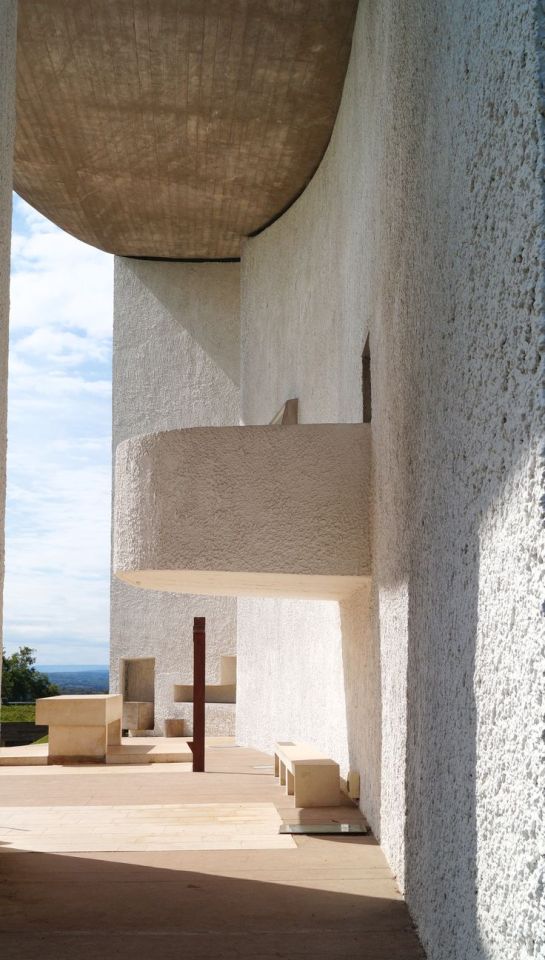
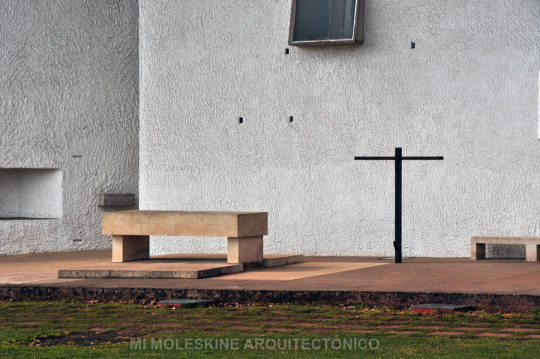



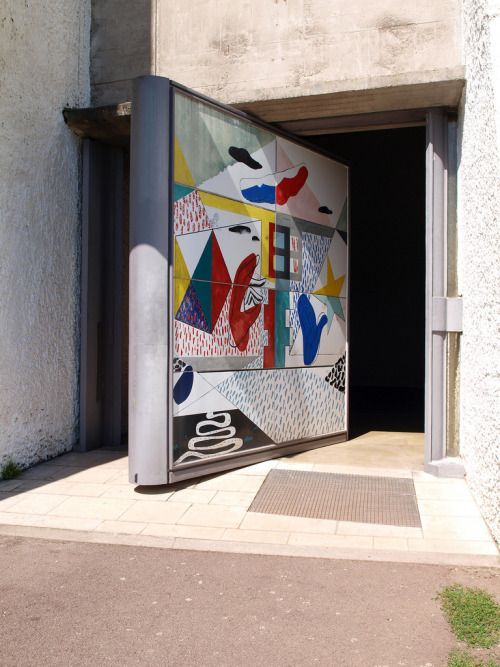


chapelle notre-dame-du-haut
architecture by le corbusier
haute-saône (france)
2 notes
·
View notes
Video
Haute-Saône, Luxeuil-les-Bains par Olivier Boyer
Via Flickr :
220524_Sony_DSC8849_HDR www.tourmag.com/Office-de-Tourisme-de-Luxeuil-les-Bains_a...
0 notes
Text




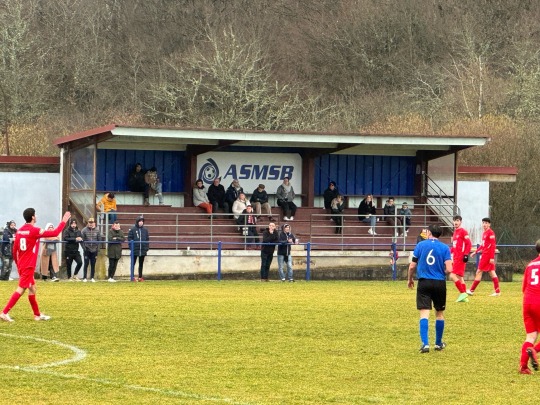



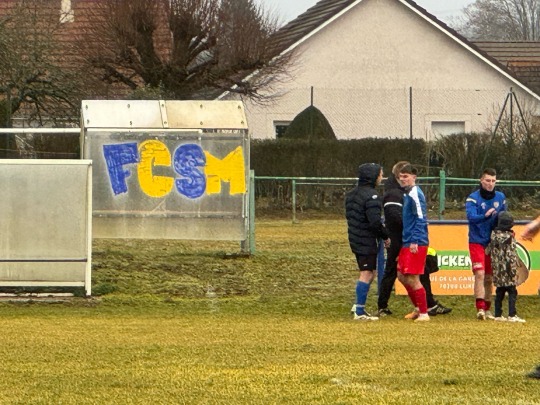
04.02.2024 AS Mélisey St Barthélemy - AS Perrousien 3:3
Stade Municipal Mélisey (50)
0 notes
Text
When talking about the French Père Noël, one has to evoke a variation of his that is NOT Saint Nicolas. I already evoked several times the various names of the Christmas gift-giver (Père Noël, Bonhomme Noël) and how he was tied to the gift-giver of the beginning of December (Saint Nicolas). But there was also a gift-giver at the end of the year... A gift giver of New Year's Eve or New Year's Day. Remember when I talked before of "Père Etrennes" or "Bonhomme Etrennes"? The "étrennes" are a French tradition whose closer English equivalent would be the word "handsel/hansel".
The étrennes were originally gifts that were given to friends, family and other next of kind at the beginning of January to celebrate New Year. Today the tradition has massively evolved - étrennes are given at the end of December rather than early January, it is money rather than gifts, and they are now a gesture of kindness destined to those employed by you or that work for the community (the fireman, the mailman, the housekeeper, the garbage collector...). But despite this evolution, "étrennes" stayed associated with an appreciative and kind giving gesture around New Year. And where there's gifts, there's a gift-giver...
This website presents us with this picture, a 1930s postcard, and says it could be the Père Fouettard... or the Père Janvier (Father January).
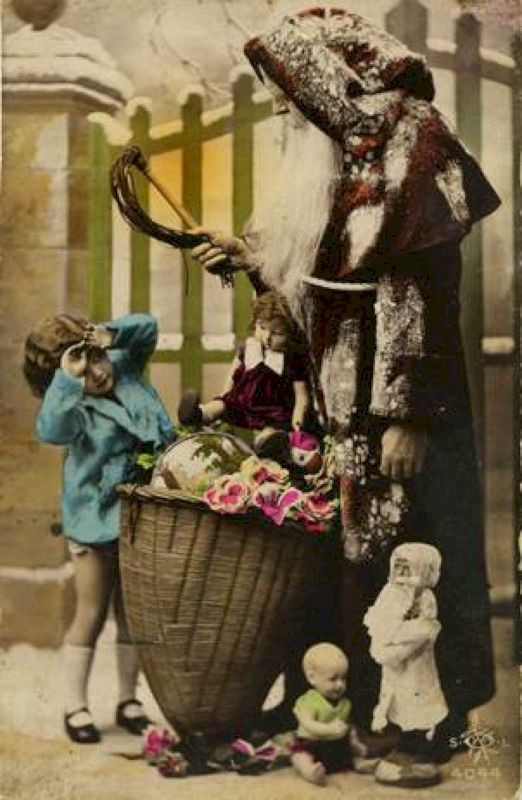
In the French region of Bourgogne, there was no "Père Noël" or Father Christmas in the early 20th century: rather there was Father January, Père Janvier, who came around New Year to give the étrennes - the gifts. By the 1930s the tradition was still very strong, especially in the Morvan and the Nivernais - as well as in the Nord-Pas-de-Calais (Father January had moved to the North of France when in the mid 19th century a lot of people from the Morvan went to work in the mines there). And from the 1930s to the 1960s, in all those areas, there was a transition from Père Janvier to Père Noël, resulting in the children of those three decades to have the benefit of two mysterious supernatural benefactors coming at the end of the year... Before Père Janvier stopped coming by the 60s, definitively replaced by Père Noël (the Americanized one of course, remember post-50s Père Noël is just Santa Claus with a different name).
This other website goes into more details about the world of Père Janvier - or rather of Bonhomme Janvier (Old Man January/The January Man).

Le Père Janvier, or Bonhomme Janvier, existed for a very long time in the tradition of the Berry region, before the Père Noël was even introduced. Not just in the Berry, but also in the Morvan and in all of Bourgogne - and even in many others areas of France! Lyon knew of him, the Haute Marne, Saône-et-Loire, Ardèche - they all had records of Father January, this white-bearded old man that brought gifts to children on the 1st of January. In the Berry region, the Père Janvier usually left sweets inside in their slippers for New Years Day, and on New Years Eve chimneys were carefully cleaned up so he could enter the house unsoiled.
And just like Saint Nicolas or Père Noël, Bonhomme Janvier ALSO was followed by Père Fouettard, with his wicker basket filled with "martinets" (beating/whipping tools for naughty children):

While sometimes Bonhomme Janvier brought many toys or sweets (found in the children's shoes or "sabots" placed by the chimney), there was one tradition according to which Janvier only ever brought one item per person, not more - with sometimes a sweet or candy to accompany it (often it was a pipe made of sugar). Tradition claimed it was because Père Janvier hated greedy or gluttonous children - but more realistically, it was probably just a tale invented by poor families to justify the lack of gifts...
And of course, as Père Noël arrived in the 20th century, Bonhomme Janvier slowly faded away...

#french folklore#christmas lore#père janvier#father january#father christmas#new years eve#new years day#new year folklore#père noël#père fouettard
86 notes
·
View notes
Text

BOULT - Haute Saône
L'utilitaire est d'époque. Le garage aussi.
25 notes
·
View notes
Text
1976-Joachim Peiper

Joachim Peiper (30 January 1915 – 14 July 1976) was a German Schutzstaffel (SS) officer and war criminal convicted for the Malmedy massacre of U.S. Army prisoners of war (POWs). During the Second World War in Europe, Peiper served as personal adjutant to Heinrich Himmler, leader of the SS, and as a tank commander in the Waffen-SS. Peiper personified Nazi ideology as a purportedly ruthless glory-hound commander who was indifferent to the combat casualties of Battle Group Peiper, and who encouraged, expected, and tolerated war crimes by his Waffen-SS soldiers.

As adjutant to Himmler, Peiper witnessed the SS implement the Holocaust with ethnic cleansing and genocide of Jews in Eastern Europe; facts that he obfuscated and denied in the post–War period. As a tank commander, Peiper served in the 1st SS Panzer Division Leibstandarte SS Adolf Hitler (LSSAH) in the Eastern Front and in the Western Front, first as a battalion commander and then as a regimental commander. Peiper fought in the Third Battle of Kharkov and in the Battle of the Bulge, from which battles his eponymous battle group – Kampfgruppe Peiper – became notorious for committing war crimes against civilians and PoWs.

In the Malmedy Massacre Trial, the U.S. military tribunal established Peiper's command responsibility for the Malmedy massacre (1944) and sentenced him to death, which later was commuted to life in prison, then 35 years. In Italy, Peiper was accused of having committed the Boves massacre (1943); that investigation ended for lack of war-crime evidence that Peiper ordered the summary killing of Italian civilians.

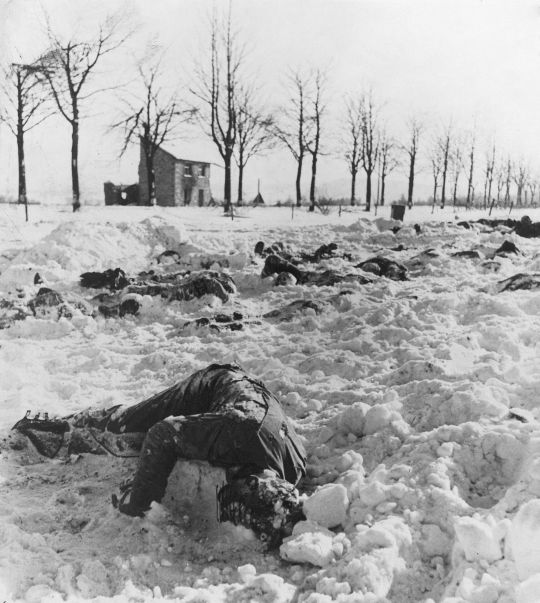


Upon release from prison, Peiper worked for the Porsche and Volkswagen automobile companies and later moved to France, where he worked as a freelance translator. Throughout his post-war life, Peiper was very active in the social network of ex–SS men centred upon the right-wing organisation HIAG (Mutual Aid Association of Former Members of the Waffen-SS).

In 1972, Joachim and Sigurd Peiper moved to Traves, Haute-Saône, in eastern France, where he owned a house. Under the pseudonym "Rainer Buschmann", Peiper worked as a self-employed English-to-German translator for the German publisher Stuttgarter MotorBuch Verlag, translating books of military history.[27] Despite his biography and working pseudonymously, they lived under his true, German name, "Joachim Peiper", and soon attracted the notice of anti-fascists.

The confirmation of Peiper's Nazi identity and presence in France attracted journalists to whom Peiper readily gave interviews, wherein he claimed that he was a victim of Communist harassment due to his role in the war. In an interview (J’ai payé "I Already Have Paid"), Peiper said he was an innocent man who had paid for his war crimes (referring to the Malmedy massacre) with twelve years of prison. He said he was innocent of the earlier Boves massacre war crime in Italy. He also said "In 1940, French people weren't brave, that's why I'm here". These insulting remarks angered the press and residents. It was reported that he and his wife left France and moved to the German Federal Republic due to ongoing death threats.

On Bastille Day 14 July 1976, French anti-Nazis attacked and torched Peiper's house in Traves. When the fire was extinguished, firefighters found the charred remains of a man holding a pistol and a .22 calibre rifle, as if defending himself.[128] The arson investigators determined that person had died from smoke inhalation. The anti-Nazi political group The Avengers claimed responsibility for the arson that killed Peiper; nonetheless, because of the destruction caused by the arson, the French police authorities remained unconvinced that Joachim Peiper was the person found.
24 notes
·
View notes
Photo

Sylvain Wiart
Renoir et blanc
Joseph Alexandre Renoir
Sculpteur français (né à Gray (Haute Saône) le 9 mai 1811, décédé en janvier 1855), Renoir suit l’enseignement de Jules Ramey et de James Pradier.
Il expose pour la première fois au Salon de 1847.
Il est l’auteur d’un cycle de la Passion (Calvaire à Lestelle Bétharram), d’Horace enfant (Musée de Toulouse) et d'Eve couchée (prise ici au musée de Picardie à Amiens).
31 notes
·
View notes
Text
@bruxtia mentioned a statue found of a (perhaps) female version of Cernunnos. Which reminded me that I actually wrote a piece about that in 2020 but never shared here.
Cernuna?
I got a question on Twitter by a follower who wondered if I have any information about the Goddess Cernuna. I must admit, I’d read the name once in passing, while reading about Cernunnos, but I never really dove further into it, thinking that it was simply a modern pagan’s wishful thinking. After the question, however, I got curious. Is there a female counterpart to Cernunnos? Do we have evidence of a Gaulish female antlered Goddess?
Short answer: sort of.
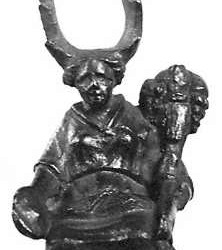
Above is a bronze statue of an antlered woman, sitting crosslegged, holding a cornucopia and a patera: a gallo-roman offering dish. The statue is currently in the British Museum, but was found at Broye in the Haute-Saône (Franche-Comté). Interesting is of course that she had antlers, and the fact that she is sitting cross-legged, something that most Cernunnos depictions have as well.

Another antlered goddess, sitting cross-legged, holding a cornucopia was discovered in Puy-de-Dôme. Her other hand is empty but was likely holding another patera. She can be seen in the Musée de Clermont-Ferrand.
The cornucopia is a symbol of abundance and prosperity. The patera is one of worship, of leaving offerings for a deity. However, often the figures holding the patera would not be the deity themself, but those who would bring offerings to them. So are we looking at statues of Goddesses, or of priestesses? Horns (or antlers) indicate a link to nature and the hunt. Which would make these potential Goddesses a Goddess of nature, the hunt, and abundance (and perhaps the harvest).

Photo by Alexander Schimmeck on Unsplash
There is also mention of a relief of a horned (not antlered) Goddess found on a piece of pottery in Richborough, Kent, but I wasn’t able to find an image of this.
Of course we know next to nothing about these figures. Their name, or what their attributes entailed. Cernuna or Cernunna would be a suitable name, meaning “horned” but whether or not She would have a link to Cernunnos is impossible to know. And if She did have a link to Cernunnos, what would it be? Is She His consort, His wife, His sister, His female form? An interesting concept to think about.
Sources:
We Are Star Stuff – Cernunnos
We Are Star Stuff – Horned Goddesses
DeoMercurio – Cernunnos
Noémie Beck – Goddesses in Celtic Religion
Ceisiwr Serith – Cernunnos: Looking a Different Way
Sharon Paice MacLeod – Celtic Cosmology and the Otherworld: Mythic Origins, Sovereignty and Liminality pg. 152-154
Miranda Green – Symbol and Image in Celtic Religious Art pg. 26-27
Miranda Green – Animals in Celtic Life and Myth pg. 237
Georgia Irby-Massie – Military Religion in Roman Britain pg. 100
50 notes
·
View notes
Text
Donne chien border 1 an - Haute Saône à Valay
🇨🇵💔🐕⚠️ URGENTISSIME ADOPTEZ SVP
2 notes
·
View notes
Text
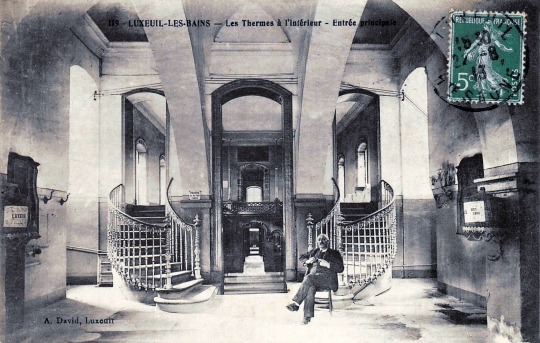
Intérieur des Thermes, Luxeuil-les-Bains, Haute-Saône.
6 notes
·
View notes
Text
Les gendarmes de la Haute-Saône (F) ont dû avoir un petit sourire en coin à la lecture de la plaque d'immatriculation de cette voiture belge, dimanche. Le conducteur de cette BMW a choisi le mot «Aperooo» pour se distinguer des autres résidents. Un choix qui a beaucoup amusé les gendarmes français, qui ont partagé la photo sur leur page Facebook, l'occasion également d'avertir les automobilistes les plus drôles. «Bonjour à nos amis belges et leurs plaques d’immatriculation personnalisables. Ça ne vous dispensera pas de contrôles.» La publication a fait littéralement le buzz, déjà plus de 10’000 likes, plus de 1000 commentaires et 2500 partages

4 notes
·
View notes
Video
Haute-Saône, Fougerolles par Olivier Boyer
Via Flickr :
220520_Sony_DSC8741_752_11_HDR L'eco-musée de la cerise ecomusee-fougerolles.fr/infos/ Ouvert du 15 février au 30 juin et du 1er septembre au 15 novembre, tous les jours sauf le mardi, de 14h à 18h. En juillet et août, tous les jours de 11h à 19h. Le kirsch AOC, fabrication de l’écomusée du pays de la cerise Durée de la visite : 1h15 Adresse : 206 le Petit-Fahys 70200 Fougerolles. 03 84 49 52 50 Mail : [email protected]
0 notes
Text

"File:2020-09 - TdF 2020 - Saint-Germain (Haute-Saône) - 34.jpg" by A.BourgeoisP is licensed under CC BY-SA 4.0.
#skinsuit#lycra bulge#lycra#bibshorts#cycling bulge#guys in lycra#skintight#beardsandtattoos#bib shorts#lycra spandex#spandex
3 notes
·
View notes
Text
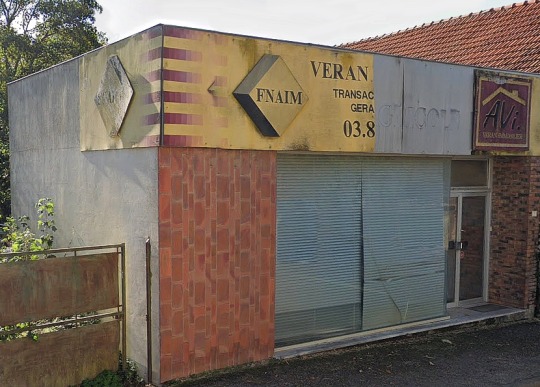
AUTREY LES GRAY - Haute Saône
Pour un adhérent de " Renaissance ", ça la fout mal...
14 notes
·
View notes


